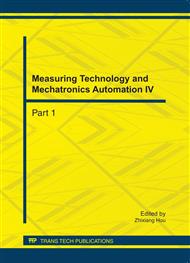[1]
IEEE802. 16e-2006. IEEE standard for local and metropolitan area networks, Part 16: Air Interface for Broadband Wireless Access Systems C Amendment for Physical and Medium Access Control Layers for Combined Fixed and Mobile Operation in Licensed Bands. 2006-10-1. http: /ieeexplore. ieee. org/ISOL/ standardstoc. jsp?punumber=10438.
DOI: 10.1109/ieeestd.2006.99107
Google Scholar
[2]
Ye W, Heidemann J, Estrin D. Medium Access Control with Coordinated Adaptive Sleeping for Wireless Sensor Networks . IEEE/ACM Trans. Networking. 2004, 12 (3): 493-506.
DOI: 10.1109/tnet.2004.828953
Google Scholar
[3]
Xue Jianbin,Yuan Zhanting. A novel algorithm of sleep mechanism in IEEE 802. 16e An Adaptive Power Saving Strategies based on Cross-layer Design in IEEE 802. 16e . Journal of Networks. 2010,Vol. 5, No. 3:359-366.
DOI: 10.4304/jnw.5.3.359-366
Google Scholar
[5]
Lei Kong, Danny H.K. Tsang, Performance Study of Power Saving Classes of Type I and II in IEEE 802. 16e. IEEE Comm. Letters, 1999, 3(3): 63- 65.
Google Scholar
[5]
Niu Z S, Zhu Y F, Benetis V. A phase-type based Markov chain model for IEEE 802. 16e sleep mode and tts performance analysis . The Institute of Electrical and Electronics Engineers. 20th International Teletraffic Congress. Ottawa: IEEE, 2007: 17-21.
DOI: 10.1007/978-3-540-72990-7_69
Google Scholar
[6]
Xiao Y. Energy saving mechanism in the IEEE 802. 16e wireless MAN . IEEE Communications Letters, 2005, 9: 595 - 597.
DOI: 10.1109/lcomm.2005.1461675
Google Scholar
[7]
Zhang Y, Fujise M. Energy Management in the IEEE 802. 16e MAC [J]. IEEE Communications Letters", 2006, 10(4): 311-313.
DOI: 10.1109/lcomm.2006.1613757
Google Scholar
[8]
K. Fall and K. Varadhan, Ns notes and documentation. http: ∥www-mash. cs. berkeley. edu/ns.
Google Scholar
[9]
Zhu S Q, Wang T L. Enhanced power efficient sleep mode operation for IEEE 802. 16e based WiMAX . The Institute of Electrical and Electronics Engineers. IEEE Mobile WiMAX'07 . Orlando: IEEE, 2007: 25-29.
DOI: 10.1109/wimax.2007.348699
Google Scholar
[10]
Xiao J.F., Zou S. H., Rer B, Cheng S. D. An Enhanced Energy Saving Mechanism in IEEE 802. 16e[A]. IEEE GLOBECOM 2006, California, USA, 2006: 27, November-1, December.
Google Scholar
[11]
Koen L, Halkes G. Energy-efficient medium access control. 2007-09-20. http: /www. isa. ewi. tudelft. nl/koen/papers/ MAC- chapter. pdf.
Google Scholar


